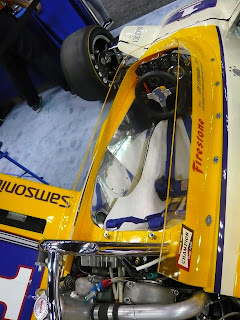1972 Vel's Parnelli Jones Racing Team VPJ-1
Maurice Philippe started his career designing
airplanes before he joined Lotus Cars in 1965. Phillipe worked with Colin Chapman
and redesigned the Lotus 39, and then drew the BRM-powered Lotus 43. The next Phillipe
design was the classic Lotus 49 and later Philippe was involved in the design
of the 1968 Lotus four-wheel drive turbine Indianapolis cars.
Phillipe’s master stroke was the Lotus 72, a dramatic
Formula 1 design which broke new ground by mounting the radiators alongside the
driver in sidepods, a design that McLaren Cars adapted for the M16 USAC car
that won the Indianapolis pole position in 1971. In late 1971, Maurice left Lotus
to work as a free-lance designer.
Philippe's 1972 design for the Vel’s Parnelli Jones
(VPJ) Racing Team featured wings sprouting at a 45-degree angle off the
monocoque known as dihedral wings which also contained the radiators. Most
shocking there was no rear wing mounted behind the turbocharged Offenhauser
engine.
The new Parnelli also featured new Phillipe-designed suspension technology known as dual
camber compensators meant to keep the triangular shaped chassis monocoque level in all racing conditions.
The VPJ team was the first of the modern “super
teams” with a lineup of top drivers, mechanics, and strong sponsorship so
expectations were high for the new car. The team featured drivers Joe Leonard,
Al Unser and Mario Andretti, Leonard was the defending United States Auto Club
(USAC) national champion in the PJ Colt, a chassis that was copied from a Lola design.
Unser was the two-time and defending Indianapolis
500-race race winner, while Andretti was a three-time USAC national champion
and the 1969 Indianapolis champion. George Bignotti the multiple time Indianapolis
winning mechanic was the team’s chief mechanic paired with mechanics John Capels and Jim
McGee.
Leonard’s car carried season long sponsorship from Samsonite
luggage, while Andretti’s and Unser’s cars carried full sponsorship from Viceroy
cigarettes. The sponsorship was supplemented with a massive influx of funding
from the Firestone Tire and Rubber Company, which was engaged in a “tire war”
with Goodyear Tire and Rubber Company.
A press photo from the 1972 VPJ-1
unveiling at Ontario Motor Speedway
author's collection
The VPJ team and the national auto racing media
gathered at the Ontario Motor Speedway in March 1972 for the car’s introduction,
and after a coin flip with teammate Mario Andretti, Al Unser took the prototype
out for its first laps. After several laps Unser pulled into the pits and
Andretti then took the car out for some slow laps, then drove directly to the
garage area. Shortly thereafter the press outing ended.
Not disclosed to the press was the fact that the
car, known as the VPJ-1 was a horrible combination – it was both scary and slow.
The team went to work to revise the design and develop the VPJ-1. The team used
the older Colt chassis at the season-opening race in Phoenix, then the new car
debuted at Indianapolis minus the dihedral wings, with a conventional
suspension system and more typical front and rear wings.
In the 1972 Indianapolis 500, the VPJ-1 finished
second, third, and eighth. Later in the
1972 USAC season, Joe Leonard won three consecutive races – a 200-mile race at
Michigan, the Pocono 500-mile race, and the Tony Bettenhausen 200 at Milwaukee.
On the strength of those results, Joe Leonard captured his second straight USAC
national championship with Al Unser in fourth place in the 1972 points.
Despite the early problems, Maurice Phillipe penned
the 1973 Vel’s Parnelli Jones Racing Team entry, the VPJ-2, the VPJ-3 used
sparingly in the 1974 USAC season (the team switched to 1974 AAR Eagle customer
chassis for most of the season) and the VPJ-4 ill-fated Formula 1 car powered
by a Cosworth engine.
The Vintage Indy Registry displayed VPJ-1 chassis
#102 owned by Chuck Jones was shown in its original dihedral wing configuration at the 2018 Performance Racing
Industry (PRI) trade show. The car is expertly restored as it appeared in early
season testing.
This chassis was driven by Joe Leonard to a third-place finish at
the Indianapolis Motor Speedway, and Leonard drove chassis #102 to the
three wins during the 1972 season at Michigan, Pocono, and Milwaukee until the was damaged in a tire testing crash before the season-ending race at Phoenix, and Leonard drove VPJ chassis 104 at Phoenix.
Leonard crashed chassis #104 in practice and did not start the Best Western 150. Fortunately for Leonard, he had a commanding points lead over second place Billy Vukovich and claimed his second consecutive USAC National driving Championship.
All photos by the author except as noted











No comments:
Post a Comment